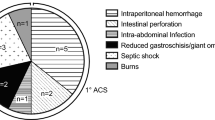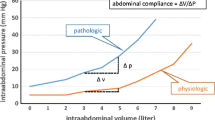Abstract
Purpose
The abdominal compartment syndrome (ACS) in childhood is a rare but dire disease if diagnosed delayed and treated improperly. The mortality amounts up to 60% (Beck et al. in Pediatr Crit Care Med 2:51–56, 2001). ACS is defined by a sustained rise of the intraabdominal pressure (IAP) together with newly developed organ dysfunction. The present study reports on 28 children with ACS to evaluate its potential role in the diagnosis, treatment and outcome of ACS.
Methods
Retrospectively, medical reports and outcome of 28 children were evaluated who underwent surgical treatment for ACS. The diagnosis of ACS was established by clinical signs, intravesical pressure-measurements and concurrent organ dysfunction.
Results
Primary ACS was found in 25 children (89.3%) predominantly resulting from polytrauma and peritonitis. Three children presented secondary ACS with sepsis (2 cases) and combustion (1 case) being the underlying causative diseases. Therapy of choice was the decompression of the abdominal cavity with implantation of an absorbable Vicryl® mesh. In 18 cases the abdominal cavity could be closed later, while in the other ten cases granulation of the mesh was allowed. The overall survival rate was 78.6% (22 of 28 children). The cause of death in the remaining six cases (21.4%) was sepsis with multiorgan failure.
Conclusion
Our results suggest that early establishment of the specific diagnosis of ACS followed by swift therapy with reduction of intraabdominal hypertension is essential in order to further reduce the high mortality rate associated with this condition.



Similar content being viewed by others
References
Beck R, Halberthal M, Zonis Z, Shoshani G, Hayari L, Bar Joseph G (2001) Abdominal compartment syndrome in children. Pediatr Crit Care Med 2:51–56
Light M (2006) Abdominal compartment syndrome: historical background. In: Ivatury RR, Cheatham ML, Malbrain ML, Sugrue M (eds) Abdominal compartment syndrome. Of country of bioscience. Landes Bioscience, Georgetown, pp 1–7
Puneet MS, Chauhan V, Singh S, Gupta SK, Shukla VK (2007) Abdominal compartment syndrome: in old syndrome, a new perspective. Trop Gastroenterol 4:156–158
Bertram P, Schachtrupp A, Rosch R, Schumacher O, Schumpelick V (2006) Abdominelles Kompartmentsyndrom. Chirurg 77:573–579
Diaz FJ, Fernandez A, Gotay F (2006) Identification and management of abdominal compartment syndrome in the pediatric intensive care unit. P R Health Sci J 25:17–22
Eijke JC, Humpert S, Bahjri K, Mathur M (2007) Outcomes of children with abdominal compartment syndrome. Acta Clin Belg Suppl 1:141–148
Hobson KG, Young KM, Ciraulo A, Palmieri T, Greenhalgh DG (2002) Releases of abdominal compartment syndrome improves survival in patients with burn injury. J Trauma 53:1129–1134
Maxwell RA, Fabian TC, Croce MA, Davis KA (1999) Secondary abdominal compartment syndrome: in underappreciated manifestation of serve hemorrhagic shock. J Trauma 47:995–999
Neville HL, Lally KP, Cox CS (2000) Emergent abdominal decompression with patch abdominoplasty in the pediatric patient. J Pediatr Surg 35:705–708
Groger A, Bozkurt A, Piatkowski A, Franconian E, Steinau G, Fox P, Pallua N (2005) Ischaemic necrosis of small and generous intestine in a 2-year old child with 20% partial thickness burns. Burns 31:930–932
Kimball EJ, Rollins MD, Mone MC, Hansen HJ, Baraghoshi GK, Johnston C, Day IT, Jackson PR, Payne M, Barton RG (2006) Survey of intensive care physicians on the recognition and management of intra abdominal hypertension and abdominal compartment syndrome. Crit Care Med 34:2340–2348
Malbrain MLNG (2004) Different techniques to measure intra abdominal pressure (IAP): time for a critical Re appraisal. Intensive Care Med 30:357–371
Sukhotnik I, Riskin A, Bader D, Lieber M, Shamian B, Coran AG, Mogilner J (2009) Possible importance of increased intra-abdominal pressure for the development of necrotising enterocolitis. Eur J Ped Surg 19:307–310
Davis PJ, Koottayi S, Taylor A, Butt WW (2005) Comparison of indirect methods of measurement intra abdominal pressure in children. Intensive Care Med 31:471–475
Suominen PK, Pakarinen MP, Rautiainen P, Mattila I, Sairanen H (2006) Comparison of direct and intravesical measurement of intraabdominal pressure in children. J Pediatr Surg 41:1381–1385
Jensen ARE, Hughes WB, Grewal H (2006) Secondary abdominal compartment syndrome in children with burns and trauma: a potentially lethal complication. J Burn case Res 27:242–246
Meier C, Schramm R, Holstein JH, Seifert B, Trentz O, Menger MD (2006) Measurement of compartment pressure of the rectus sheath during intraabdominal hypertension in rats. Intensive Care Med 32:1644–1648
DeCou JM, Abrams RS, Miller RS, Gauderer MWL (2000) Abdominal compartment syndrome in children: experience with three cases. J Pediatr Surg 35:840–842
Kawar B, Siplovich L (2003) Abdominal compartment syndrome in children: the dilemma of treatment. Eur J Pediatr Surg 13:330–333
Morell BJ, Vinden C, Singh RN, Kornecki A, Fraser DD (2007) Secondary abdominal compartment syndrome in a case of pediatric trauma shock resuscitation. Pediatr Crit Care Med 8:67–70
DeLaet I, Malbrain MLNG (2007) ICU management of the patients with intra abdominal hypertension: what to do, when and to whom? Acta Clin Belg Suppl 1:190–199
Kimball EJ, Kim W, Cheatham ML, Malbrain MLNG (2007) Clinical awareness of intra abdominal hypertension and abdominal compartment syndrome in 2007. Acta Clin Belg Suppl 1:66–73
Schachtrupp A, Jansen M, Bertram P, Kuhlen R, Schumpelick V (2006) Abdominal compartment syndrome: significance, diagnosis and treatment. Anaesthesist 55:660–667
Cheatham ML, Safcsak K (2008) Longterm impact of abdominal decompression: a prospective comparative analysis. J Am Coll Surg 207(4):573–579 [Epub 2008 Jul 21]
Author information
Authors and Affiliations
Corresponding author
Rights and permissions
About this article
Cite this article
Steinau, G., Kaussen, T., Bolten, B. et al. Abdominal compartment syndrome in childhood: diagnostics, therapy and survival rate. Pediatr Surg Int 27, 399–405 (2011). https://doi.org/10.1007/s00383-010-2808-x
Accepted:
Published:
Issue Date:
DOI: https://doi.org/10.1007/s00383-010-2808-x




